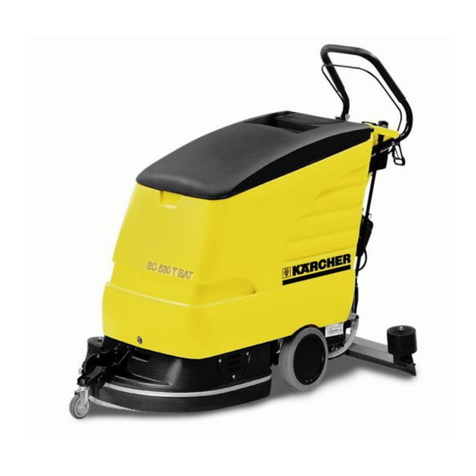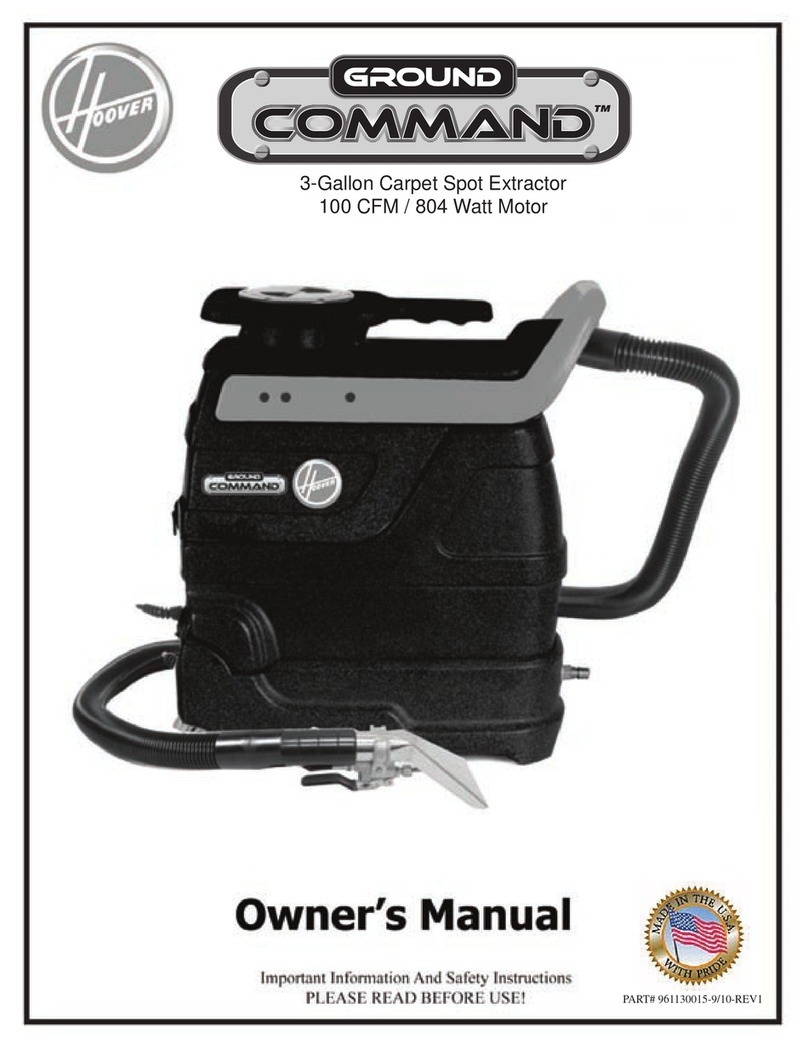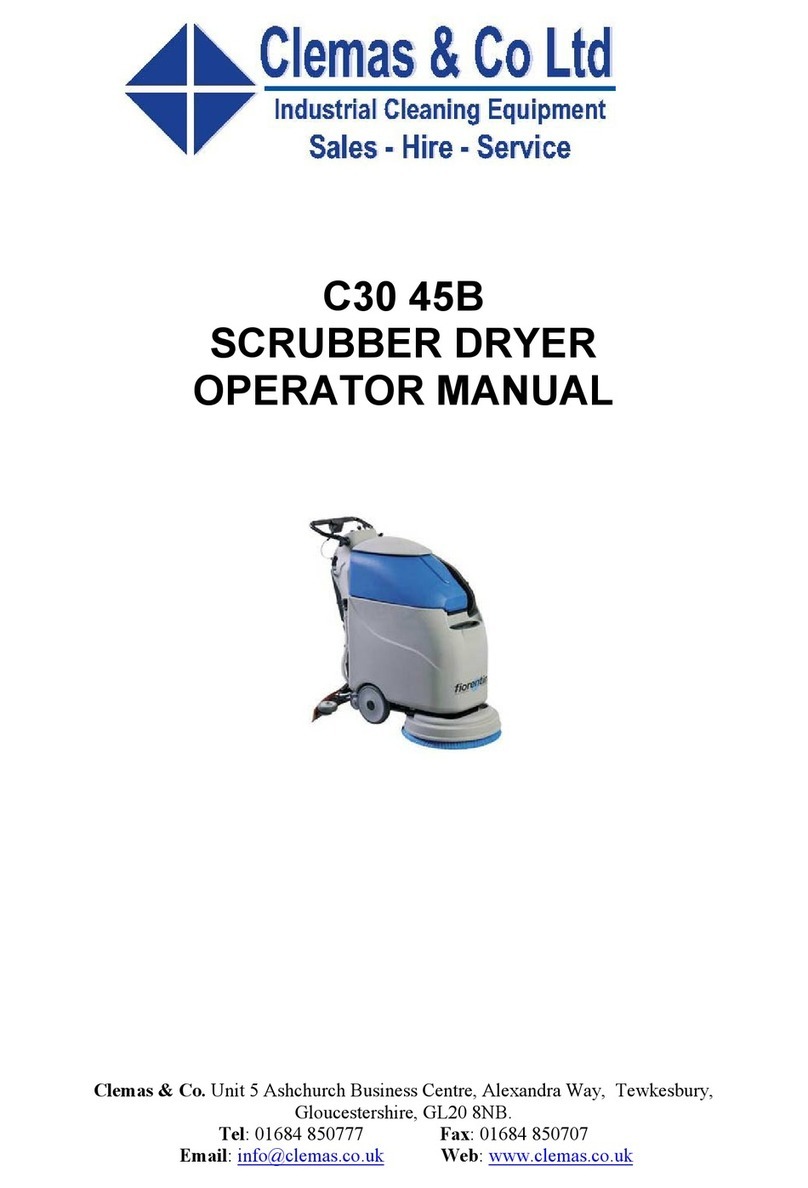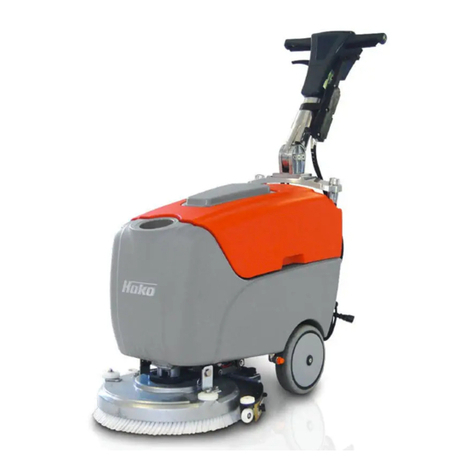Tornado Karcher BR 40/25 C Bp User manual

!
English 3
Français 18
Español 35
BR 40/25 C Bp
BD 40/25 C Bp
5.961-762 2011660 09/05


English 3
IMPORTANT SAVETY INSTRUCTIONS 3
Safety Devices 6
Symbols 6
Function 6
Proper Use 6
Environmental Protection, Disposal 6
Operating and Functional Elements 7
Before Commissioning 8
Unloading 8
Batteries 8
Installing the Brushes 10
Installing the Vacuum Bar 10
Operation 10
Filling Detergents 10
Driving to the Place of Use 11
Cleaning Programs 11
Battery Control Display 11
Setting the Vacuum Bar 11
Setting the Advance Speed 12
Cleaning 12
Shutting Down the Appliance 12
Emptying the Dirt Water Reservoir 12
Emptying the Fresh Water Reservoir 12
Transport 12
Maintenance and Care 13
Maintenance Schedule 13
Maintenance Tasks 13
Frost Protection 14
Faults 14
Faults with Display 15
Faults without Display 15
Specifications 16
Warranty 17
To reduce the risk of fire, electric shock, or
injury:
–Do not leave appliance when plugged in.
Unplug from outlet when not in use and
before servicing.
–TO REDUCE THE RISK OF ELECTRIC
SHOCK-USE INDOORS ONLY
–Do not allow to be used as a toy. Close
attention is necessary when used by or
near children.
–Useonlyasdiscribed inthismanual.Use
only manufacturer`s recommended
attachments.
–Do not use with damaged cord or plug. If
appliance is notworking asit should,has
been dropped, damaged, left outdoors,
or dropprd into water, return it to a
service center.
–Do not pull or carry by cord, use cord as
a handle, close a door on cord, or pull
cord around sharp edges or corners. Do
not run appliance over cord. Keep cord
away from heated surfaces.
–Do not unplug by pulling on cord. To
unplug, grasp the plug, not the cord.
–Do not handle plug or appliance with wet
hands.
–Do not put any object into openings. Do
not use with any opening blocked; keep
free of dust, lint, hair, and anything that
may reduce air flow.
–Keep hair, loose clothing, fingers, and all
parts of body away from openings and
moving parts.
–Turn off all controls before unplugging.
–Use extra care when cleaning on stairs.
Contents IMPORTANT SAFETY IN-
STRUCTIONS
READ ALL INSTRUCTIONS
BEFORE USING.
WARNING
WARNING

4 English
–Do not use to pick up flammable or
combustible liquids, such as gasoline, or
use in areas where they may be present.
–Connect to a properly grounded outlet
only. See Grounding Instruction.
This appliance must be grounded. If it
should malfunction or breakdown, ground-
ing provides a path of least resistance for
electric current to reduce the risk of electric
shock. This appliance is equipped with a
cord having an equipment-grounding con-
ductor and a grounding plug. The plug must
be inserted into an appropriate outlet that is
properly installed and grounded in accor-
dance with all local codes and ordinances.
Improper connection of the equipment
grounding conductor can result in a risk of
electric shock. Check with a qualified electri-
cian or service person if you are in doubt as
to whether the outlet is properly grounded.
Do not modify the plug provided with the ap-
pliance-if it will not fit the outlet, have a prop-
er outlet installed by a qualified electrician.
This appliance is for use on a nominal 120-
volt circuit and has a grounding attachment
plug that looks like the plug illustrated in
sketchpicture A. Make sure that the
appliance is connected to an outlet having
the same configuration as the plug. No
adaptor should be used with this appliance.
1Grounded outlet
2Grounded outlet Box
3Grounded Pin
Save operation is in the responsibility of the
operator.
The operator shall be familiar with the oper-
ation and function of all controls and instru-
ments before undertaking to operate the
unit.
Before operating the unit, operators shall
haveread andbefamiliar withthe operator’s
manual for the particular unitbeingoperated
and they shall also abide by the safety rules
and practices in the following paragraphs.
Before operating any unit, the operator shall
befamiliarwithunusualoperatingconditions
which may require additional safety precau-
tions or special operating instructions.
Before starting to operate the unit be in op-
erating position.
Do not start or operate the unit, any of its
functions or attachments, from any place
other than from the designated operators
position.
Before leaving the operator’s position:
A bring the unit to a complete stop;
SAVE THESE INSTRUCTIONS
GROUNDING INSTRUCTIONS
WARNING
CONNECT TO A PROPERLY
GROUNDED OUTLET ONLY
OPERATING SAFETY RULES
AND PRACTICES
Operator Responsibility
General

English 5
B ifthe unitmust be onan incline,block the
wheels.
Maintain a safe distance from the edge of
ramps, platforms, and other similar working
surfaces.
Do not add to, or modify the unit.
Do not block access to fire aisles, stairways
or fire equipment.
Yield the right of way to pedestrians and
emergency vehicles such as ambulances
and fire trucks.
Cross railroad tracks at an angle wherever
possible. Do not park closer than 6 ft (1800
mm) to the nearest rail of a railroad track.
Keep a clear view of the path of travel and
observe for other traffic, personnel, and safe
clearances.
Under all travel conditions, operate the unit
at a speed that will pernit it to be brought to
a stop in a safe manner.
Do not indulge in stunt driving or horseplay.
Slow down for wet and slippery floors.
Before driving over a dockboard or bridge
plate, be sure that it is properly secured.
Drive carefully and slowly across the dock-
board or bridge plate, and never exceed its
rated capacity.
When negotiating turns, reduce speed to a
safe level consistent with the operating envi-
ronment. Make the turns smoothly.
If the unit is found to be in need of repair or
in any way unsafe, or contributes to an un-
safe condition, the matter shall be reported
immediately to the user’s designated author-
ity, and the unit shall not be operated until it
has been restored to safe operating condi-
tion.
If during operation the unit becomes unsafe
in any way, the matter shall be reported im-
mediatelyto the user’s designated authority,
and the unit shall not be operated until it has
been restored to safe operating condition.
Do not make repairs or adjustments unless
specifically authorized to do so.
Operation of the unit may be hazardous if
maintenance is neglected or repairs, re-
builds, or adjustments are not performed in
accordance with the manufacturer’s design
criteria. Therefore, maintenance facilities
(on or off premises), trained personnel, and
detailed procedures shall be provided.
Maintenance and inspection of the unit shall
be performed in conformance with the fol-
lowing practices:
A a schedules planned maintenance, lubri-
cation, and inspection system shall be
followed; consult the manufacturer’s rec-
ommendations.
B only tranined and authorized personnel
shall be permitted to maintain, repair, ad-
just, and inspect the unit, and in accord-
ance with manufacturer’s specifications.
Avoid fire hazards and have fire protection
equipment present in the work area. Do not
use open pans of fuel or flammable cleaning
fluids for cleaning parts.
Any unit not in safe operating condition shall
be removed from service.
Repairs shall not be made in Class I, Class
II, and Class III locations.
Fire Prevention: The unit shall be kept in a
clean condition and reasonably free of lint,
excess oil, and grease. Noncombustible
agents are preferred for cleaning the unit.
Flammableliquids [thosehaving flashpoints
at orabove 100°F(37,8°C)]are notallowed.
Precautions regarding toxicity, ventilation,
and fire hazard shall be appropriate for the
agent or solvent used.
Nameplate Visibility: The unit type designa-
tions as shown on the nameplate and the
type markers shall not be covered over with
paintsothat theiridentificationinformationis
obscured.
The unit shall not be used in classified are-
as.
Travelling
Operator care of the unit
MAINTENANCEANDREBUILD
PRACTICES
FIRE SAFETY STANDARD

6 English
Before using the appliance for the first time,
read and observe these operating instruc-
tions and the accompanying brochure: Safe-
ty information for brush cleaning units and
spray-extraction units, 5.956-251.
Safety devices serve to protect the user and
must not be rendered inoperational or their
functions bypassed.
To render brush drive immediately inopera-
tional, release the control handle.
The following symbols are used in this oper-
ating manual:
Danger
Indicates an immediate threat of danger.
Failure to observe the instruction may result
in death or serious injuries.
몇Warning
Indicates a possibly dangerous situation.
Failure to observe the instruction may result
in light injuries or damage to property.
Note
Indicates useful tips and important informa-
tion about the product.
The appliance is used for wet cleaning or
polishing level floors. It can be easily adjust-
ed to the cleaning task by setting a cleaning
program and the water quantity.
A working width of 400mm and a capacity of
25l each of the fresh and dirt water reser-
voirs enable effective cleaning.
Note
The appliance can be equipped with various
accessoriesdependingonthecleaningtask.
Please request our catalogue or visit us on
the Internet at www.kaercher.com.
Only use this appliance as directed in these
operating instructions.
– The appliance may only be used for the
cleaning of hard surfaces that are not
sensitive to moisture and polishing oper-
ations.
Theapplicationtemperaturerangesfrom
+5°C to +40°C.
– Theappliance isnotsuitablefor cleaning
frozen floors (e.g. in cold stores).
– The appliance may only be equipped
with genuine accessories and spare
parts.
– Theappliance hasbeendesignedforthe
cleaning of interior floors or covered sur-
faces. For other areas of application, the
use of alternative brushes must be
checked.
– The appliance is not intended for the
cleaning of public traffic routes.
– Take the permissible floor surface load-
ing into account.
The appliance is not suitable for use in
potentially explosive environments.
Safety Instructions
Safety Devices
Control handle
Symbols
Function
Proper use
Environmental Protection,
Disposal
The packaging materials are re-
cyclable. Please do not throw
packaginginthe domesticwaste
but pass it on for recycling.
Old units contain valuable recy-
clable materials. Batteries, oil
and similar substances may not
be released into the environ-
ment. Therefore please dispose
of old units through suitable col-
lection systems.

English 7
1 Push handle
2 Control handle
3 Star grip push handle fastening
4 Filling level display and fresh water dis-
charge hose
5 Battery *
6 Cleaning head
7 Battery control display
8 Brush motor overload display
9 Program selection switch
10 Water quantity regulator
11 Wing nuts for tilting vacuum bar
12 Wing nuts for fastening vacuum bar
13 Vacuum bar lowering lever
14 Electronics
15 Running gear for transport
16 Tank fixing screw
17 Fresh water reservoir filler neck
18 Fluff filter
19 Dirt water reservoir
20 Dirt water reservoir cover
21 Float
22 Suction hose
23 Vacuum bar *
24 Dirt water discharge hose
25 Star grips for exchanging vacuum lips
26 Splashguard
27 Brush rollers (BR model)/ Disk brushes
(BD model)
* not included in delivery
Operating and Functional Elements

8 English
ÎReleasethestargrips ofthepushhandle
fastening.
ÎTurn the push handle backwards and
tighten the star grips.
ÎPlace the long lateral packaging boards
as a ramp next to the pallet.
ÎFix the ramp to the pallet with nails.
ÎPlace the short boards underneath the
ramp as a support.
ÎRemove the wooden bars in front of the
wheels.
ÎPush the appliance down the ramp from
the pallet.
Please observe the following warning notes
when handling batteries:
Danger
Danger of explosion. Do not put tools or sim-
ilar on the battery, i.e. on the terminal poles
and cell connectors.
Risk of injury. Ensure that wounds never
come into contact with lead. Always clean
your hands after working with batteries.
ÎDrain tanks if necessary.
ÎTurn the running gear to the front with
your foot.
Before Commissioning
Unloading
Batteries
Safety
Observe the notes on the battery
and in the operating instructions
Wear eye protection
Keep children away from acid and
batteries
Danger of explosion
Fire, sparks, naked flames and
smoking must be strictly avoided
Danger of chemical burns
First aid
Warning note
Disposal
Do not throw the battery into the
regular waste
Inserting and connecting batteries

English 9
몇Warning
The cable at the rear of the machine can get
damaged. Always tilt the chassis forward be-
fore tilting the tank backward.
ÎUnscrew the screw and swing the tank
backwards.
ÎLift the battery cover.
ÎInsert the battery.
ÎScrew down the fastening angle behind
the batteries.
몇Warning
Observe the correct polarity.
ÎConnect the positive pole of one battery
to the negative pole of the next battery.
ÎConnnect the connecting cable to the
free battery poles (+) and (-).
ÎReplace the battery cover.
ÎSwing the tank downwards and secure it
with the screw.
몇Warning
Charge the batteries before commissioning
the appliance.
Note
The appliance is fitted with low charge pro-
tection, that is, the appliance is switched off
when a minimum capacity level is reached.
If this is the case, the battery monitor on the
operator console lights up red. Always re-
charge discharged (and partially dis-
charged) batteries.
Danger
Never use the charger in the rain, at high hu-
midity levels or in damp rooms!
Note
Average charging time is around 10-12
hours.
ÎRemove the battery plug and connect to
the charging cable.
Note
Connect the charger to the detachable bat-
tery plug at the machine and not to the plug
installed on the machine.
ÎSwitch the charger on
ÎCorrect the acid level by adding distilled
water an hour before the end of the
charging procedure. The batteries are
correspondingly marked.
Danger!
Risk of injury! Adding water when the batter-
ies are discharged can cause acid to es-
cape! Wear protective goggles when
handling battery acid and observe guide-
lines to prevent injury and damage to
clothes. Rinse any splashed acid on skin or
clothing with large quantities of water.
몇Warning!
Only use chemically pure battery acid (as
per VDE 0510) of density 1.28 kg/l. Use dis-
tilled or desalinated water only to refill batter-
ies (VDE 0510). Do not use any additives
(so-called improvement agents) otherwise
all warranties will be void.
ÎUnplug the charger from the mains.
ÎIn the case of models without a built-in
cable: remove the battery cable from the
charging cable and connect it to the ap-
pliance.
Charging the batteries
–
+
–
+
Charging procedure for
BR/BD 40/25 Bp
Non-maintenance-free batteries
After charging:

10 English
If wet batteries are to be used with the Bp
model, please note the following:
– The maximum battery dimensions must
be observed.
When charging low-maintenance batter-
ies, the manufacturer’s guidelines must
be observed (see maintenance sched-
ule)
The brushes must be installed before the in-
itial operation (see "Maintenance works").
ÎInsert the vacuum bar into the vacuum
bar suspension in such a manner that
theprofiledsheetispositionedabovethe
suspension. Tighten the wing nuts.
ÎInsert the suction hose.
몇Warning!
Risk of damage. Raise the vacuum bar be-
fore reversing.
Note
To render the brush drive immediately inop-
erational, release the control handle.
몇Warning
Riskofdamage.Onlyusetherecommended
detergents. With respect to different deter-
gents the operator bears the increased risk
regarding the operational safety and danger
of accident. Only use detergents that are
free from solvents, hydrochloric acid and hy-
drofluoric acid.
Note
Do not use highly foaming detergents. Ob-
serve the dosing notes.
Recommended detergents:
ÎOpen the cover of the fresh water reser-
voir.
ÎFill in the water detergent mixture up to
the MAX marking of the filling level dis-
play. Maximum temperature of the liquid
60°C.
ÎClose the cover of the fresh water reser-
voir.
Maximum battery dimensions
Length Width Height
330mm 171mm 235mm
Installing the Brushes
Installing the Vacuum Bar
Operation
Filling in Detergents
Application Detergent
Routine cleaning of all wa-
ter resistant floors RM 745
RM 746
Routine cleaning of glossy
surfaces (e.g. granite) RM 755 es
Routine cleaning and basic
cleaning of industrial floors RM 69
Routine cleaning and basic
cleaning of fine stoneware
tiles
RM 753
Routine cleaning of tiles in
sanitary areas RM 751
Cleaning and desinfection
in sanitary areas RM 732
Removal of coating from all
alkali-resistant floors (e.g.
PVC)
RM 752
Removal of coating from li-
noleum floors RM 754

English 11
When the running gear is turned to the front
the appliance can be pushed to the place of
use without any contact of the brushes with
the floor.
ÎRaise the vacuum bar.
ÎPress the appliance to the bottom using
the push handle.
ÎTurn the running gear to the front with
your foot.
ÎUse the push handle to push the appli-
ance to the place of use.
1 OFF Appliance is not operational.
2 Scrub cleaning Wet cleaning the floor
and vacuum up dirt water.
3 Wet scrubbing Wet cleaning the floor
and allow the detergent to react.
4 Vacuuming Vacuuming up the detergent
solution.
5 Polishing Polishing the floor without the
application of liquid.
The battery control display shows the charg-
ing status of the batteries when the charger
is unplugged:
To improve the vacuuming result on tiled
floors the vacuum bar can be turned to an
oblique position of up to 5°.
ÎRelease the wing nuts.
ÎTurn the vacuum bar.
ÎTighten the wing nuts.
If the vacuum result is unsatisfactory the in-
clination of the straight vacuum bar can be
modified.
ÎRelease the wing nuts.
ÎTilt the vacuum bar.
ÎTighten the wing nuts.
Driving to the Place of Use
Cleaning Programs
Battery control display
40-100% lights green
20-40% lights yellow
0-20% slowly flashes red
empty lights red
1
2
34
5
Setting the Vacuum Bar
Oblique position
Inclination

12 English
ÎTurn the running gear to the front with
your foot.
ÎReducing the speed: Turn the wheel in –
direction.
ÎIncreasing the speed: Turn the wheel in
+ direction.
ÎTurn the running gear to the back with
your foot.
ÎTurn the program selection switch to the
desired cleaning program.
ÎSet the water quantity according to the
degree of dirt accumulation and the floor
covering.
ÎLower the vacuum bar.
ÎTurn on the brushes by pulling the con-
trol handle.
몇Warning!
Risk of damage to the floor covering. Do not
operate the appliance on the spot.
ÎClose the water quantity regulator.
ÎDrive the appliance forward for another
1-2m to draw off residual water.
ÎTurn the program selection switch to
"OFF".
ÎRaise the vacuum bar.
ÎSwing the running gear to the front using
your foot.
몇Warning!
Danger of deformation of the brush(es).
When shutting down the appliance, relieve
the brush(es) by swinging the running gear
forward.
Note
If the dirt water reservoir is full the float clos-
es the suction channel. The suction opera-
tion is interrupted. Empty the dirt water
reservoir.
몇Warning
Please observe the local provisions regard-
ing the wastewater treatment.
ÎTake the dirt water discharge hose from
the support and lower above a suited col-
lection device.
ÎLet off water by opening the dosage de-
vice at the discharge hose.
ÎThe rinse the dirt water reservoir with
clear water.
ÎRelease the coupling at the upper end of
the fill level display.
ÎLower the hose for the fill level display
into a suitable collector and drain off liq-
uid.
ÎEngage the coupling on the appliance
again.
ÎIf you want to transport the appliance on
a vehicle secure it from slipping.
Setting the advance speed (BD
model only)
Cleaning
Shutting Down the Appliance
Emptying the Dirt Water Reservoir
Emptying the fresh water tank
Transport

English 13
To reduce the required space the push han-
dle can be turned to the front:
ÎReleasethestargrips ofthepushhandle
fastening.
ÎTurn the push handle to the front.
Danger
Risk of injury. Turn the program selection
switch to "OFF" and disconnect the mains
plug before performing any work on the ap-
pliance.
ÎDrain and dispose of the dirt water and
the residual fresh water.
몇Warning
Risk of damage. Do not wash down the ap-
pliance with water and do not use aggres-
sive detergents.
ÎDrain off dirt water.
ÎCheck the fluff filter, clean if required
ÎClean the outside of the appliance with a
damp cloth which has been soaked in
mild detergent.
ÎClean the vacuum lips and the splash-
guard, check for wear and replace if re-
quired.
ÎCheck the brushes for wear, replace if
required.
ÎCharge the batteries if required.
ÎIf appliance is temporarily out of use:
perform an adjustment charge of the bat-
tery.
ÎCheck the battery pole for oxidation. If
required, brush off and apply pole
grease. Ensure stability of the connect-
ing cables.
ÎChecktheconditionofthesealsbetween
dirt water reservoir and cover, replace if
required.
ÎCheck for acid leaks on the cells of non-
maintenance-free batteries.
ÎClean the brush tunnel. (BR model only)
ÎHave the prescribed inspection carried
out by the customer service.
ÎRemove the vacuum bar.
ÎUnscrew the star grips.
ÎRemove the plastic parts.
ÎRemove the vacuum lips.
ÎInsert new vacuum lips.
ÎInsert the plastic parts.
ÎScrew in and tighten the star grips.
ÎEmpty the dirt water reservoir.
ÎPress the appliance to the bottom using
the pushing handle.
ÎSwing the running gear to the front with
your foot.
ÎPress in the brush and remove down-
wards.
ÎInsert the new brush roller and lock into
place.
ÎSwing the running gear backwards with
your foot.
Maintenance and Care
Maintenance Schedule
After working
Monthly
Yearly
Maintenance Tasks
Replacing the vacuum lips
Replacing the brush rollers

14 English
ÎEmpty the dirty water reservoir.
ÎPresstheappliancedownusingthepush
handle.
ÎTurn the running gear to the front with
your foot.
ÎTurn the button for setting the advance
speed in – direction.
ÎRaise the disk brushes.
ÎTurn the disk brushes through approxi-
mately 45°.
ÎRemove the disk brushes downwards.
ÎInsert the new disk brushes in reverse
sequence.
ÎSet the advance speed.
ÎTurn the running gear to the rear with
your foot.
To ensure a reliable operation of the appli-
ance maintenance contracts can be con-
cluded with the competent Kärcher sales
office.
In case of danger of frost:
ÎEmpty the fresh and dirt water reser-
voirs.
ÎStore the appliance in a frost-protected
room.
Danger
Risk of injury. Turn the program selection
switch to "OFF" and disconnect the mains
plug before performing any works on the ap-
pliance.
ÎDrain and dispose of the dirt water and
the residual fresh water.
In case of faults that cannot be remedied us-
ing the table below, please contact the cus-
tomer service.
Replacing the disk brushes
Maintenance contract
Frost protection
Faults

English 15
Faults with Display
Battery con-
trol display Overload
display Fault Remedy
– flashes
rapidly Brush drive ex-
cess temperature Switch the program selection switch to
OFF and let the appliance cool down.
– flashes
slowly Wrong cable con-
nections will lead
todisruptionsand
overload on the
brushes.
Switchprogram selection switch toOFF.
Thenreselectthecleaningprogram.Call
customer service if fault persists.
– lights Electronic fault
rapidly flash-
es red flashes
rapidly Defective battery
slowly flash-
es red flashes
slowly Short circuit cus-
tomer Set program switch to OFF. Wait for a
while. Select the cleaning program
again. If the fault recurs, call customer
service.
Faults without Display
Fault Remedy
Appliance cannot be start-
ed Check batteries, charge if necessary
Check battery pole fuse at the plus pole of the battery (75A);
if the fuse is defective, call customer service.
Insufficient water quantity Check the fresh water level, refill tank if required
Check if the hoses are blocked, refill tank if required
Insufficient vacuum per-
formance Clean the seals between dirt water reservoir and cover and
check for tightness, replace if required.
Clean the fluff filter
Clean the vacuum lips on the vacuum bar, replace if required
Check if the suction hose is blocked, clean if required
Check the suction hose for tightness, clean if required
Check that the cover on the dirt water discharge hose is closed
Check the setting of the vacuum bar.
Insufficient cleaning result Check the brushes for wear, replace if required
Brushes do not turn Check if foreign bodies are blocking the brushes, remove for-
eign bodies if required

16 English
Specifications
BR 40/25 C Bp BD 40/25 C Bp
Power
Nominal voltage V 24 24
Battery capacity Ah (5h) – –
Average power consumption W 1200 1200
Suction engine output W 600 600
Brush engine output W 600 600
Vacuuming
Cleaning power, air quantity l/s 30 30
Cleaning power, negative pressure, max. kPa 130 130
Cleaning brush
Working width mm 400 390
Brush diameter mm 96 385
Brush speed 1/min 1350 140
Dimensions and weights
Theoretical surface cleaning performance m²/h 1600 1600
Fresh/dirt water reservoir volume l 25 25
Length (without push handle) mm 800 870
Width (without vacuum bar) mm 575 575
Height (without push handle) mm 830 830
Weight (without batteries, without tank con-
tents) kg 55 61
Noise emission
Mean sound level according to EN 60704 dB(A) 70 70
Machine vibrations
Vibration total value (ISO 5349) m/s² 1,0 1,0

English 17
Thetermsof theguarantee thatisapplicable
in each country have been published by our
respective national distributors. Any fault
that occurs with your appliance during the
guarantee period will be repaired free of
charge, provided that it has been caused by
a material or manufacturing defect. Guaran-
tee claims should be addressed to your
dealer or the nearest authorized customer
service depot, and supported by documen-
tary evidence of purchase.
You will find a list of spare parts at the end of
these operating instructions.
Warranty
Spare parts

18 Français
INSTRUCTIONS IMPORTANTES EN MA-
TIÈRE DE SÉCURITÉ 18
Dispositifs de sécurité 21
Symboles 21
Fonction 21
Usage conforme 22
Protection de l'environnement, gestion
des déchets 22
Eléments de commande 23
Avant la mise en service 24
Déchargement 24
Batteries 24
Montage des brosses 26
Montage de la barre d'aspiration 26
Utilisation 26
Remplissage de carburant 26
Déplacement vers le lieu d'utilisation 27
Programmes de nettoyage 27
Indicateur de contrôle de la batterie 27
Réglage de la barre d'aspiration 28
Réglage de la vitesse de traction avant 28
Nettoyage 28
Arrêt et mise hors fonction 28
Vidange du réservoir d'eau sale 29
Vidange du réservoir d'eau propre 29
Transport 29
Entretien et maintenance 29
Plan de maintenance 29
Travaux de maintenance 30
Protection antigel 30
Pannes 30
Pannes avec affichage 31
Pannes sans affichage 32
Caractéristiques techniques 33
Garantie 34
Pour réduire les risques d'incendie, de chok
électrique ou de blessure:
–Ne pas laisser l'appareil sans
surveillance lorsqu'il est branché.
Débrancher lorsque l'appareil n'est pas
utilisé et avant l'entretien.
–Pour réquire les risques de choc
électrique, utiliser à l'interieur
seulement.
–Ne pas permettre aux enfants de jouer
avecl'appareil.Uneattentionparticulière
est nécessaire lorsque l'appareil est
utilisé par des enfants ou à proximité de
ces derniers.
–N'utiliser que conformément à cette
notice avec les accessoires
recommandés par le fabricant.
–Ne pas utiliser si le cordon ou la fiche est
endommagé. Retourner l'appareil à un
atelier de réparation s'il ne fonctionne
pas bien, s'il est tombé ou s'il a été
endommagé, oublie à l'extérieur ou
immergé.
–Ne pas tirer soulever ni traîner l'appareil
par le cordon. Ne pas utiliser le cordon
comme une poignée, le coincer dans
l'embrasure d'une porte ou l'appuyer
contre des arêtes vives ou des coins. Ne
pas faire rouler l'appareil sur le cordon.
Garder le cordon à l'écart des surfaces
chaudes.
–Ne pas débrancher en tirant sur le
cordon. Tirer plutôt la fiche.
Table des matières INSTRUCTIONS IMPORTAN-
TES EN MATIÈRE DE SÉCU-
RITÉ
LIRE TOUTES LES INSTRUC-
TIONS AVANT DE FAIRE
FONKTIONNER
Attention
Attention

Français 19
–Ne pas toucher la fiche ni l'appareil
lorsque vos mains sont humides.
–N'insérer aucun objet dans les
ouvertures. Ne pas utiliser l'appareil
lorsqu'une ouverture est bloquée.
S'assurer que de la poussière, de la
peluche, des cheveux ou d'autres
matières ne réduisent pas le debit d'air.
–Maintenir les cheveux, les vêtements
amples, les doigts et toutes les parties
du corps à l'écart des ouvertures et des
pièces mobiles.
–Mettre toutes les commandes à la
position ARRÊT avant de débrancher
l'appareil.
–User de prudence lors du nettoyage des
escaliers.
–Ne pas aspirer des liquides
inflammables ou combustibles, comme
de l'essence, et ne pas faire functionner
dans des endroits où peuvent se trouver
de tels liquides.
–Ne brancher qu'à une prise de courant
avec mise à la terre. Voir les instructions
la mise à la terre.
Cet appareil doit être mis à la terre. En cas
dedéfaillance oude panne,la miseàla terre
fournit au courant un chemin de moindre ré-
sistance qui réduit le risque de choc élec-
trique. Cet appareil est pourvu d'un cordon
muni d'un conducteur de terre et d'une fiche
avec broche de terre. La fiche doit être
branchée dans une prise appropriée correct-
ement installée et mise à la terre conformé-
ment aux règlements et ordonnances
municipaux.
Un conducteur de terre mal raccordé peut
entraîner un risque de choc électrique. Con-
sulter un électricien ou un technicien d'entre-
tien qualifié si vous n'êtes pas certain que la
prise est correctement mise à la terre. Ne
pas modifier la fiche fournie avec l'appareil -
si elle ne peut être insérée dans la prise, fair
installer une prise adéquate par un élec-
tricien qualifié.
Cet appareil est destiné à un circuit de 120
V et est muni d'une fiche de mise à la terre
semblable à celle illustrée par le croqui A.
S'assurer que l'appareil est branché à une
prise de courant ayant la même configura-
tion que la fiche. Aucun adaptreur nr devrait
être utilisé avec cet appareil.
1Sortie avec mise à la terre
2Boîte avec mise à la terre
3Fiche avec mise à la terre
Un fonctionnement sûr est la responsabilité
de l'opérateur.
L'opérateur doit être au courant du fonction-
nement et des fonctions de toutes les com-
mandes et de tous les instruments avant
d'entreprendre de faire fonctionner l'unité.
Avant de faire fonctionner l'unité, les opéra-
teurs doivent avoir lu et bien connaître le
manuel d'utilisation pour l'unité particulière
en fonctionnement et ils doivent également
CONSERVER CES INSTRUC-
TIONS
INSTRUCTIONS VISANT LA
MISE À LA TERRE
Attention
NE BRANCHER QU'À UNE
PRISE DE COURANT AVEC
MISE À LA TERRE
REGLES ET PRATIQUES DE
SECURITE DE FONCTION-
NEMENT
Responsabilité de l'opérateur

20 Français
obéir aux règles et pratiques de sécurité
énoncées dans les paragraphes suivants.
Avant de faire fonctionner l'unité, l'opérateur
doit bien connaître les conditions de fonc-
tionnement inhabituelles qui peuvent néces-
siter des précautions de sécurité
supplémentaires ou des instructions de
fonctionnement spéciales.
Avant de commencer à faire fonctionner
l'unité, soyez dans une position d'opération.
Ne démarrez pas ou n'opérez pas l'unité,
l'une quelconque de ses fonctions ou acces-
soires, depuis tout endroit autre que la posi-
tion désignée pour les opérateurs.
Avant de quitter la position de l'opérateur :
A arrêtez complètement l'unité ;
B si l'unité doit se trouver sur un plan incli-
né, bloquez les roues.
Conservez une distance de sécurité depuis
le bord des rampes, plate-formes et autres
surfaces de travail similaires.
N'effectuez aucun ajout ou aucune modifica-
tion à l'unité.
Ne bloquez pas l'accès aux couloirs à incen-
die, escaliers ou équipement de lutte contre
les incendies.
Donnez la priorité aux piétons et véhicules
d'urgence tels que les ambulances et les ca-
mions de pompiers.
Traversez les voies ferrées de manière an-
gulaire si possible. Ne vous garez pas à
moins de 1800 mm du rail le plus proche
d'une voie ferrée.
Conservez une vision claire du chemin de
déplacement et prenez garde au reste de la
circulation, au personnel et aux dégage-
ments sûrs.
Opérezl'unité àune vitesse quilui permettra
d'être arrêtée de manière sûre dans toutes
les conditions de déplacement.
Ne vous adonnez pas aux cascades ou à la
brutalité.
Ralentissez en cas de sols mouillés et glis-
sants.
Avant de passer sur un bord de quai ou sur
la chaussée d'un pont, assurez-vous qu'il/
elle est correctement fixé(e). Conduisez pru-
demmentetlentementsurleborddequaiou
la chaussée d'un pont et ne dépassez ja-
mais sa capacité nominale.
Lorsdelaprise de virages,ralentissezàune
vitesse sûre en correspondance avec l'envi-
ronnement de fonctionnement. Prenez les
virages en douceur.
Si l'unité s'avère nécessiter des réparations
ou être dangereuse d'une manière quelcon-
que ou contribue à une condition dangereu-
se, le problème doit être rapporté
immédiatement au supérieur désigné de
l'utilisateur et l'unité ne doit pas être opérée
jusqu'à ce qu'elle ait été remise en une con-
dition de fonctionnement sûre.
Si l'unitédevientdangereuse d'unemanière
quelconque au cours du fonctionnement, le
problème doit être rapporté immédiatement
ausupérieurdésignédel'utilisateuretl'unité
ne doit pas être opérée jusqu'à ce qu'elle ait
été remise en une condition de fonctionne-
ment sûre.
N'effectuez pas de réparations ou de régla-
ges à moins d'y être autorisé spécifique-
ment.
Le fonctionnement de l'unité peut être dange-
reux si l'entretien est négligé ou si des répara-
tions, reconstructions ou réglages ne sont pas
effectués conformément aux critères de con-
ception du constructeur. Par conséquent, des
installationsd'entretien (sursite ouau dehors),
du personnel qualifié et des procédures dé-
taillées doivent être fournis.
L'entretien et l'inspection de l'unité doivent
être réalisés conformément aux pratiques
suivantes :
A unsystèmed'entretien,delubrificationet
d'inspection planifié doit être suivi ; con-
sultez les recommandations du cons-
tructeur.
Généralités
Déplacements
Entretien de l'unité par l'opérateur
PRATIQUES D'ENTRETIEN
ET DE RECONSTRUCTION
This manual suits for next models
1
Table of contents
Languages:
Other Tornado Karcher Floor Machine manuals
Popular Floor Machine manuals by other brands
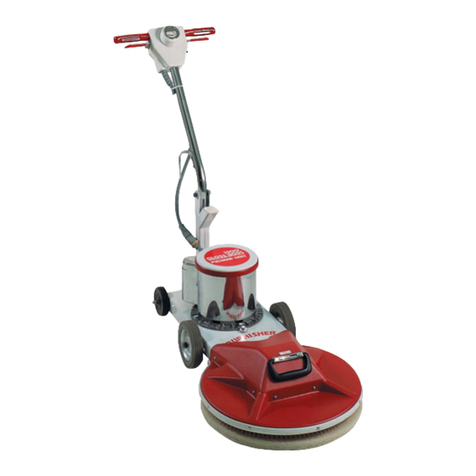
Pullman Holt
Pullman Holt Gloss Boss GB-1500F Operation & care instructions
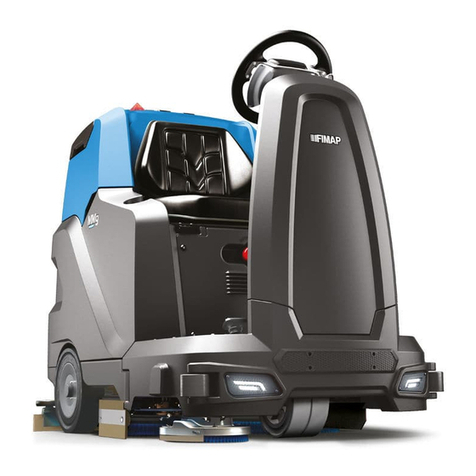
Fimap
Fimap MMg base Inspection manual

Clarke
Clarke ULTRA SPEED BURNISHER 1700 Operator's manual

Lavorwash
Lavorwash SWL 700 ET Instructions and operating manual
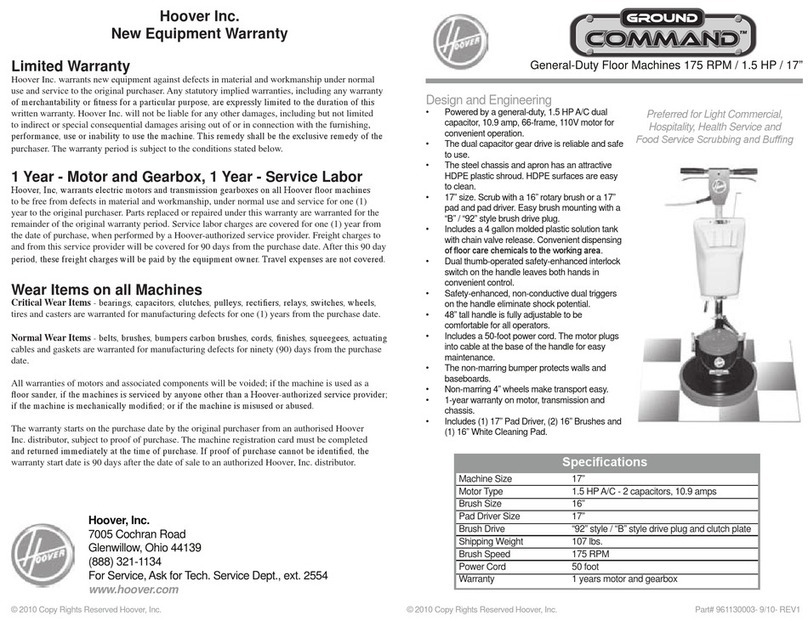
Hoover
Hoover CH83005 manual
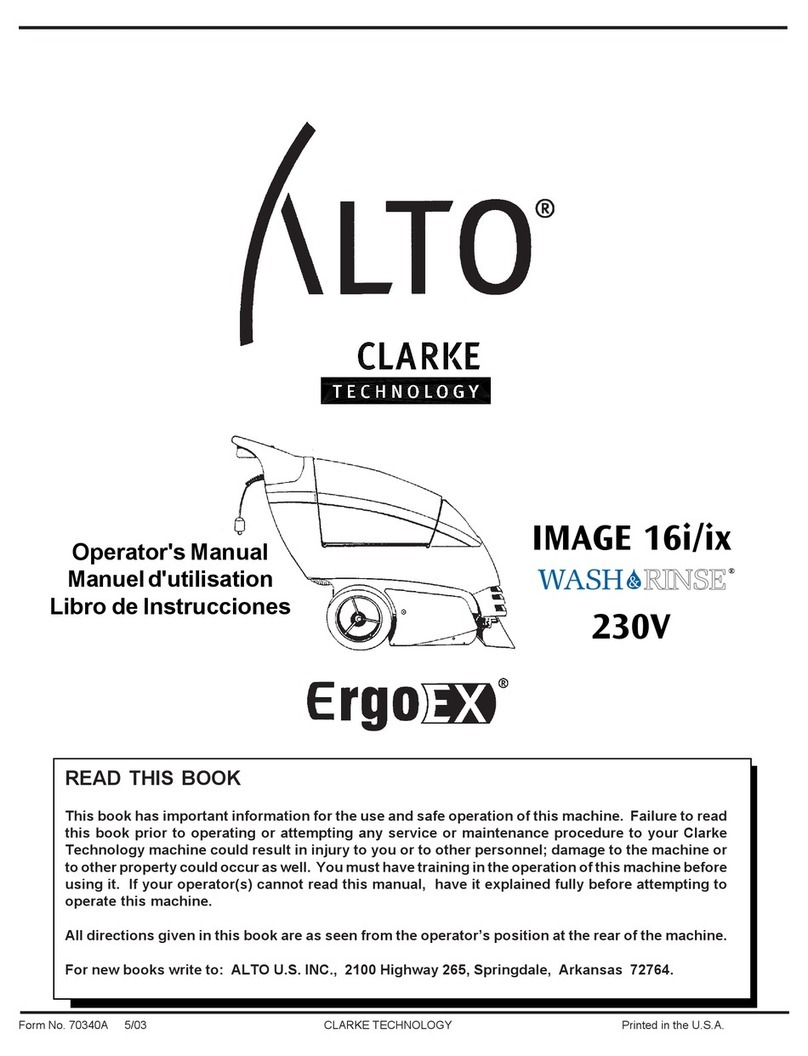
Clarke Technology
Clarke Technology ALTO ErgoEX IMAGE 16i Operator's manual
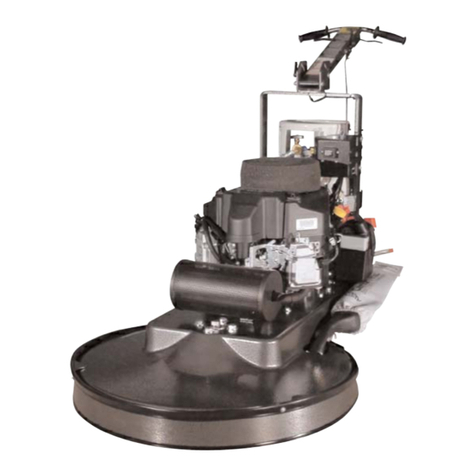
Pioneer Eclipse
Pioneer Eclipse PE420BU Operator's manual

Nilfisk-Advance
Nilfisk-Advance 66391372 Instructions for use
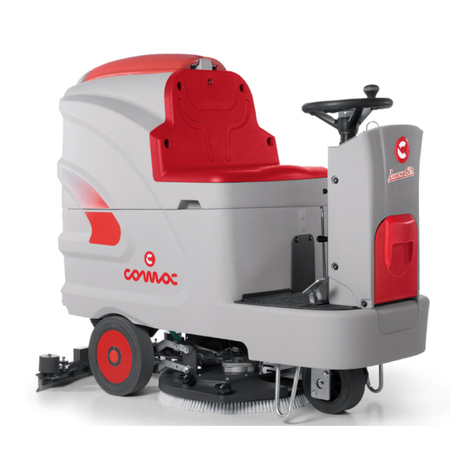
COMAC
COMAC INNOVA 2011 user manual
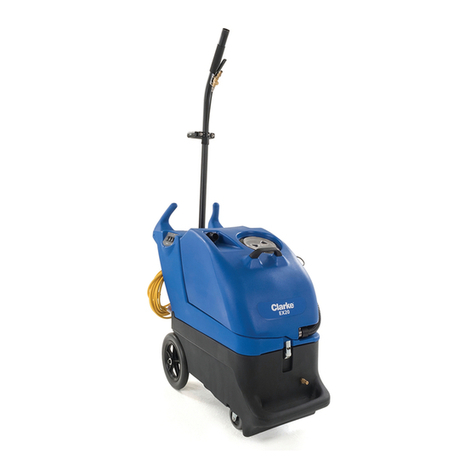
Nilfisk-Advance
Nilfisk-Advance Clarke EX20 100 Instructions for use

IP CLEANING
IP CLEANING 1250 Operator's manual
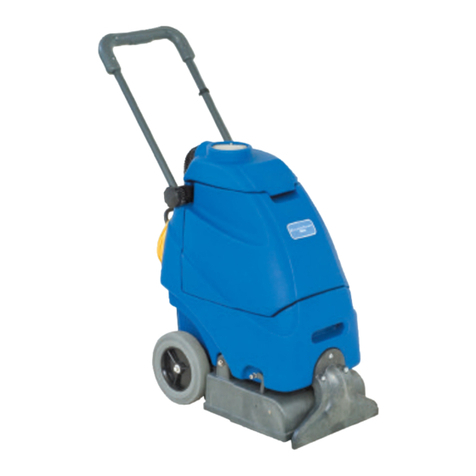
KENT
KENT Klenzor 16 MPH Specifications


